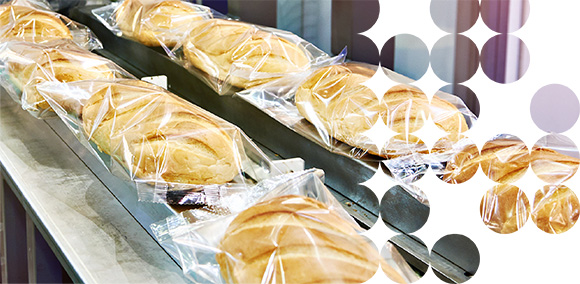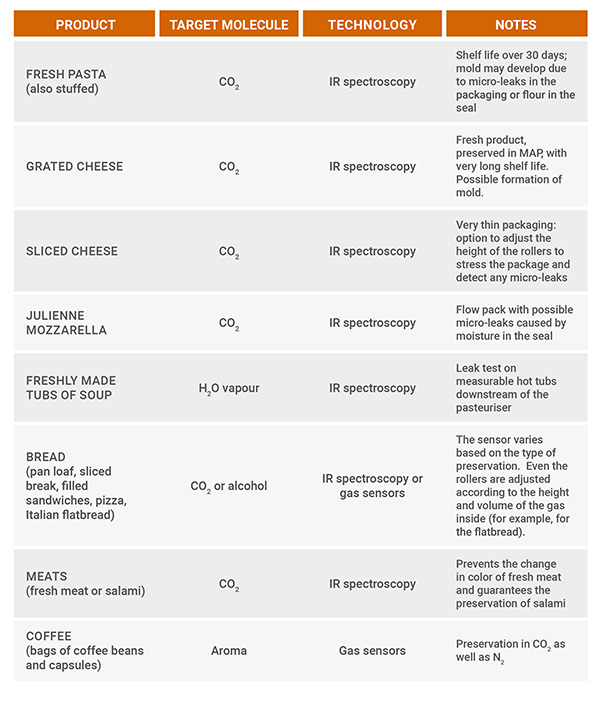In-line verification for the presence of micro-holes throughout food packaging production is possible by means of an innovative application of IR (Infrared) spectroscopy, or via gas sensors capable of detecting the leakage of target molecules present inside packages.
The areas of application sectors can be modified atmosphere packaging (MAP) packaged products, bakery products preserved with alcohol, food products preserved in nitrogen or air whose release of aromas can be detected.
Today, there are many preservation technologies available on the market for packaged food that lengthen the product’s shelf life while ensuring its organoleptic characteristics and food safety. Replacing air with a gas mixture (MAP) or with nitrogen, or by adding alcohol, are some preservation methods that cover a wide range of products. For all products, it is essential to check:
- The type of packaging, correctly barrier-coated to prevent the leakage of any preservation substances
- The gas mixture for MAP packaged products is correct for the type of product
- The presence of alcohol inside the package for bakery products
- Via seal test
This last point, checking for the presence of micro-holes in the packaging, is crucial to avoid thwarting all efforts to optimize the packaging’s preservation mixture. Therefore, let’s examine how it is possible to perform a seal test, and the innovations brought about by IR spectroscopy technology that introduce important elements of in-line monitoring of the presence of micro-holes in packaging and the seal’s integrity.

Micro-Holes in Packaging:
Consequences of Spot Checks
The presence of a micro-hole in packaging is a particularly critical problem in the food industry, since it can lead to poor food preservation and the loss of its organoleptic characteristics—as well as the possible formation of mold.
Micro-holes may form as a result of defective sealing processes or during the various processing stages of the package, and can lead to negative consequences of the product days later, when the package is already in the shop or on the shelf of a supermarket. Therefore, it is important to make sure the container is intact during the production stage.
The procedures normally in use today to check for micro-holes are spot checks, which detect the loss of pressure or leakage of gas from the package by immersing the product in water, or via an instrument that applies a “dry” vacuum. In the first case, which is called a bubble test, the product is immersed in a container filled with water that is hermetically sealed and to which an external vacuum is applied. This encourages bubbles to come out from any micro-holes, which can, at this point, be checked visually or by means of a camera.
In the second case, a vacuum is created that is carried out by placing the package inside a bell. The molecules leaked from the package (such as CO2 in the case of MAP products) or loss of pressure are indications of the presence of a micro-hole.
The main limitation of these methods is, first and foremost, that of being destructive, since it is no longer possible to reuse the tested package. Over and above this is the fact that they are, of course, merely spot checks—and therefore not comprehensive in their analysis.
Spot-checking does not check the integrity of the entire production, which means that defects are not detected on a regular basis. Moreover, this method is costly in terms of re-processing batches should a micro-hole be detected in the batch being tested.
Modern Applications for Testing In-Line Micro-Holes
The need for in-line identification of micro-holes on 100% of production is pressing, and research for possible solutions has been focused on this need in recent years. Technology is needed that must be:
- Rapid, in order to be applied to the line’s speed;
- Reliable in detecting micro-holes;
- With few false rejects, even at high speed;
- Characterized by low maintenance costs;
- Easily manageable for format changes, which are becoming increasingly frequent in production.
This has all been made possible by means of application of IR spectroscopy, or the use of gas sensors for in-line inspection of the presence of holes and micro-holes. These non-destructive technologies make it possible to detect in-line leakages in packaging, package by package, by identifying target escaping molecules.
The air around the package is extracted and taken to an analysis chamber containing an IR beam or gas sensor that can detect the presence of target molecules—and therefore micro-holes. This way, it is possible to automatically inspect every single package, avoiding problems of returns and consumer dissatisfaction caused by poor preservation.
IR Spectroscopy and Gas Sensors
The technologies that enable in-line inspection are based on nondispersive infrared technology, which offer rapid response times and reliable measured values. In the case of very small leakages, measurements with very low concentration differences or measurements by means of containers, the technology is based on the principle of laser spectroscopy.
A monochromatic radiation beam emitted by a laser interacts with the gas molecules being measured. The radiation wavelength coincides with one of the absorption lines of the molecule. Measuring the intensity and absorption profile of the radiation with a photodetector makes it possible to detect the presence of a gas, and determine the concentration of the molecule being measured.
For certain gases, the high sensitivity of measurement can be obtained by using a modulation technique of the absorption measurement known as wavelength modulation spectroscopy (WMS). It involves transmitting sinusoidal modulation to the wavelength variation of the laser radiation, then creating a beat between the signal detected from the photodetector and the modulation frequency.
The distinct advantage of WMS is that it eliminates constant contributions to the absorption, such as that of the container, thereby making it possible to significantly increase the sensitivity of the measurement. The realization of gas sensors for application in the pharmaceutical, bottling and food sectors originated at Italy’s University of Padua, where lasers have been employed to create laboratory prototypes for determining the concentration of gas pressure using absorption spectroscopy techniques.
Industrial application of these technologies has brought IR and laser spectroscopy technology to the market and into production lines, improving the way in which quality control is performed on packaged products. The non-destructive measurement techniques, based on absorption spectroscopy, are today finding new areas of use—not only to monitor package leakages, but also to monitor the internal gases and check their evolution during product shelf life.
Case History:
An In-line Control of Micro-holes in the Food Industry
Let’s explore an example of micro-hole inspection via IR spectroscopy and gas sensors, and how certain challenges might be overcome.
For one company, micro-hole inspection technology was initially working by detecting molecules leaking from packages being transferred on conveyor belts. However, during the technology transfer stage, it became evident that the pressure difference between inside and outside of the container was not enough to determine the presence of micro-holes at the line’s speed without touching the package.
To combat this, a system of rollers was implemented to apply the correct pressure to force leakage of target molecules, indicating the presence of micro-holes, without damaging the packaging or the product. The rollers are designed to stress the container and the seals to encourage gas to be released in the event of a leak.
The inspection is applicable on trays as well as bags or flowpacks. Packages are inspected at 360°, both on top and at the bottom (including any longitudinal seals) by inserting air extractors also on the sides and under the package, creating a special opening in the conveyor belts.
The target molecules that can be detected with these technologies are numerous, and vary according to the type of preservation mixture. For example, it is possible to detect CO2 as a target molecule for all MAP-preserved products, or alcohol in the case of bakery products, or specific product aromas for products packaged in air or nitrogen.

Conclusion
The in-line inspection for micro-holes in packaging through the application of IR spectroscopy, or by means of gas sensors, makes it possible to go from spot checks to in-line inspections on 100% of production. The solution can be applied on trays and bags and does not require the internal gas mixture or the line speed to be changed. It can be easily integrated in existing lines and inspection is reliable, precise and repeatable.
This quality control technology has game-changing potential for products preserved in MAP, alcohol or nitrogen, since it makes it possible to check for micro-holes in the packaging and the integrity of the seal on each individual product. From practical experience in the production line, it is evident that all micro-holes are not detected by spot checks.
In addition, a return or recall, for example for the presence of mold in fresh pasta or in cheese due to a micro-hole, causes significant economic and image damage for the company. Implementing this modern application of IR spectroscopy in the line thereby makes it possible to prevent and intervene in real time on the production process to guarantee the integrity of the package and avoid problems related to safety, quality and preservation.


